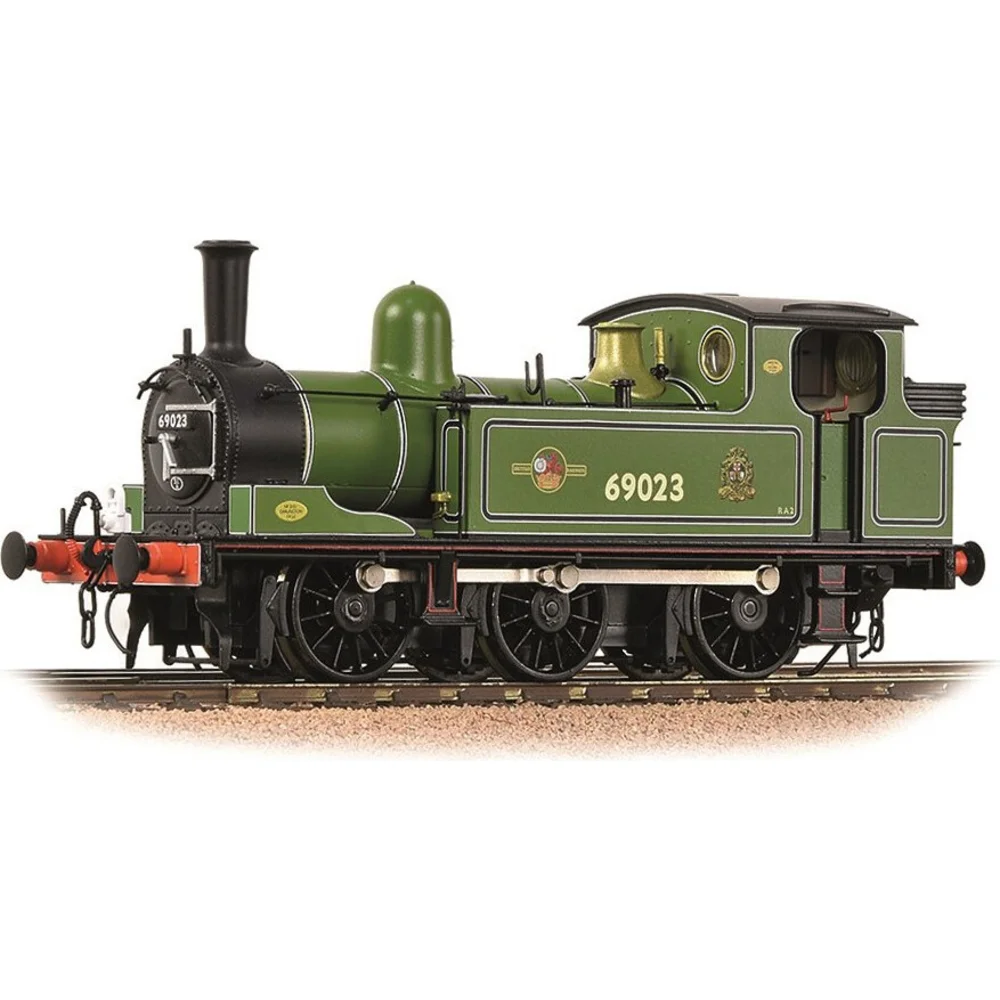Bachmann 31-060K
London & North Eastern Railway J72 69023 British Railways
Tooling
In 2019, Bachmann unveiled a completely retooled model of the LNER Class J72, replacing the decades-old ex-Mainline design. This new tooling was developed to meet modern standards for accuracy, performance, and digital capability. The prototype J72, originally introduced by the North Eastern Railway in 1898, served for over half a century, making it a popular subject for modellers. Bachmann’s 2019 redesign marked a significant leap forward in fidelity and functionality.
Tooling Features
- Scale: OO gauge (1:76).
- Construction: Highly detailed plastic body with fine rivet and panel detail, mounted on a robust die-cast chassis.
- Detailing: Separately fitted handrails, lamp irons, sprung buffers, and a fully detailed cab interior.
- Couplings: NEM pockets with tension-lock couplers for easy replacement.
Mechanical & Electrical
- Motor & Drive: Smooth-running coreless motor with flywheel, driving all axles via precision gearing.
- Minimum Radius: Compatible with standard OO curves (2nd radius and above).
- Lighting: Firebox flicker and cab lighting included on sound-fitted versions.
- Weighting: Substantial die-cast chassis for improved traction and stability.
DCC Capability
The 2019 J72 is DCC Ready with a Next18 socket. Factory-fitted sound versions are available, featuring authentic whistles, synchronized chuff, coal shovelling sounds, and controllable lighting effects.
Liveries Produced
Bachmann has released the new J72 in a wide range of historically accurate liveries, including:
- NER lined green
- LNER black (lined and plain)
- BR black (early and late crests)
- Special editions for collectors
These liveries reflect the prototype’s long service life under NER, LNER, and BR.
Performance & Reviews
The retooled J72 has been widely praised for its smooth running, fine detailing, and excellent slow-speed control, making it ideal for shunting layouts. Reviewers highlight its quiet mechanism, robust build, and ease of DCC installation. Compared to the original tooling, the new model is considered a “quantum leap” in quality.
Media & Community Commentary
Model railway forums and social media posts often describe the retooled J72 as “a benchmark for small tank engines.” Video reviews showcase its realistic motion and sound features, reinforcing its reputation as one of Bachmann’s finest small steam locomotives.
Interesting Facts
- The retooled J72 was part of Bachmann’s strategy to modernize its range with full DCC compatibility and advanced detailing.
- Sound-fitted versions include features such as synchronized chuff, firebox flicker, and cab light control.
Video Reviews
- Sam’s Trains Review – In-depth unboxing and review, performance tests, and comparison with older tooling
- Hornby Magazine Test Track – Overview of the new tooling and running performance on a realistic layout
- That Model Railway Guy – Close-up look at the NER lined green version and layout running
- Collett’s Models Review – Unboxing and first impressions of the new J72 tooling
Bachmann's Description & Specifications
OO scale models of the LNER J72 Class locomotive have long been a cornerstone of the Bachmann Branchline range, indeed J72s featured in the very first Branchline catalogue, and so we are delighted to present this all-new model of the Class as part of the current Bachmann Branchline range.
Designed from the rails up, the J72 has been modelled with a level of detail not previously seen including representation of the inside valve gear which can be seen beneath the boiler, sprung buffers and a cab interior which is fully detailed with intricate decoration. An accessory pack is supplied which includes headlamps that clip onto the locomotive’s lamp irons, plus three-link couplings and etched cab doors.
Enhancing the cab detail, the model features realistic firebox lighting which can be enjoyed when the model is used on analogue control and also DCC once a decoder has been fitted. For even more realism, choose the SOUND FITTED version and enjoy authentic sound effects on DCC and analogue control too!
Class & Prototype
- Class: London & North Eastern Railway J72
- Traction: Steam
- Built: 1898-1951
- Total Built: 113
- Running Number: 69023
- Ordered By: British Railways
- Built By: British Railways
- Built At: Darlington
- Built: 04/1951
- Withdrawn: 10/1964
- Length of Service: 13.5 years
- Running Numbers: BR 69023, BR 59
- Names: -
Operator & Livery
- Operator: British Railways
- Livery: -
- Era: 9 - Privatisation
British Railways transformed Britain's fragmented rail network into a unified national system following nationalisation on 1st January 1948. Created from the "Big Four" companies under the Transport Act 1947, BR operated most of Great Britain's railways until rebranding as British Rail in 1965, managing over 20,000 route miles and inheriting nearly 20,000 locomotives of diverse designs.
The organisation pioneered standardisation through its revolutionary BR Standard locomotive programme (1951-1960), producing 999 advanced steam engines under Robert Riddles' direction. These included the versatile Britannia Pacifics, mighty 9F freight engines, and mixed-traffic classes that incorporated the best features from all predecessor companies. The 1955 Modernisation Plan accelerated diesel and electric traction development, creating fascinating mixed-traction operations.
Notable achievements included establishing unified locomotive classification systems, introducing distinctive corporate liveries, and managing the complex transition from steam to modern traction. BR's six regional structure preserved operational diversity whilst enabling standardisation of practices, signalling, and rolling stock that had eluded private enterprise for over a century.
The BR era represents steam traction's final flowering alongside emerging diesel technology, creating unparalleled locomotive variety. Today, this heritage remains highly popular with railway enthusiasts through extensive preserved fleets, heritage railway operations, and comprehensive model ranges from manufacturers like Hornby, Bachmann, and Dapol, making BR subjects essential for authentic post-war British railway modelling across all scales.
